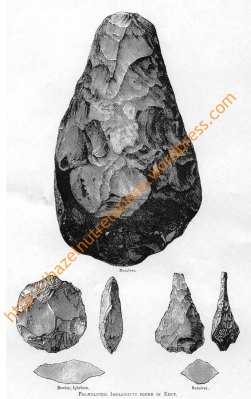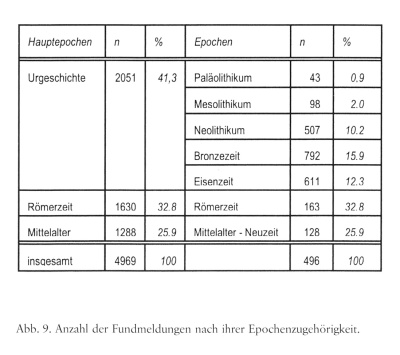This post is dedicated to all you blogging archaeologists out there going through the Good, the Bad and the Ugly of blogging. But especially to John Lowe (of whereinthehellamI fame), whose fantastic playlist helped me write this (and the part of my thesis this blog post is based on).
Imagine a settlement 14 000 years ago. Image a few round buildings. Imagine a group of people living there, a few families maybe, living by hunting gazelle and birds and gathering, amongst other plants wild legumes and wild barley (Edwards 2007; Colledge 2001). Imagine somebody going about his or her business, collecting and hunting in the vicinity of the settlement and carrying with them all they needed. Imagine this tool set, carefully held in a bag or basket, left lying near the wall of a building, a house probably. Imagine it containing a few pebbles, some with traces that show they have been used; containing a flint core from which very handy bladelets can be made; containing some more bits and pieces, a bone haft, some gazelle foot bones (phalanges) and half moon shaped flint implements, perhaps arrow- or spearheads. And a sickle.
Yes, a sickle. There are more places to find out about sickles than just the Swiss Late Neolithic. The settlement described above is a Natufian site called Wadi Hammeh 27 (Edwards 2007). It lies in the Jordan Valley. The excavators called the building Structure 1 and the finds are part of assemblage 9. It is to be expected that this assemblage of finds was once held in a bag or basket made of some organic material, which had perished by the time it was excavated. More sickle fragments and bladelets were found at Wadi Hammeh 27, as well as at other contemporary sites. Other complete or fragments of sickles have been found in Kebara cave, at El Wad, Erq el Ahmar, Oum ez-Zoueitina, Eynan (Ain Mallaha), Hayonim and Nahal Oren (Bar-Yosef 1987; Garrod, 1932). Adhesives on blades from various sites show they were hafted, as the Wadi Hammeh 27 sickle, in a straight haft or in a curved hafts (Bar-Yosef 1987). In both the experimental studies by Goodale et al (2010) and by myself straight hafts were used. Mostly, however, it is only through use wear studies that we know Natufian bladelets were used as sickles

Wadi Hammen 27. Artefact assemblage 9. From Edwards 2007, fig.2
The fact that palaeobotanical research has shown that wild legumes and wild barley were collected by the people at Wadi Hammeh 27 and used sickles makes it interesting for my use wear studies on Late Mesolithic sites in the alpine foreland of central Europe, where cerealia Type pollen is known from off-site locations, but nothing much more is known about the details of the adoption of agriculture in the region (Behre 2009; Tinner et al 2009).

Sickle haft fragments for Mugharet-El Wad. From Garrod 1932
There are a few fascinating aspects to be noted about the sickle itself. The haft is made of goat of sheep horn core. And in it two slots are made that are filled with two rows of 5 Helwan bladelets each. One row is made of pale brown flint (Munsell 10 YR 8/2, apparently) and one row of a grey flint (10YR 8/1).
I think it also fascinating that the maker or owner of the sickle thought it somehow important to make the sickle look good. In fact, it appears that more sickles of the period were decorated. There is the sickle from Nadal Heimar, which is decorated with a zick zack pattern. In fact, Goodale et al (2010) have shown that sickles of the somewhat later PPNA sites of Dhra’, Jordan, were used for an extended period of time, showing sickles were clearly important for people living through the economic and social changes of the end of the last Late Glacial and the early Holocene. Yes sickles!

BAR-YOSEF, O. 1987. Direct and Indirect evidence for hafting in the Epi-Palaeolithic and Neolithic of the Southern Levant. In: STORDEUR, D. (ed.) La Main et l’Outil. Manches et emmanchements préhistoriques. Table Ronde C.N.R.S. tenue à lyon du 26 au 29 novembre 1984. Lyon: Maison de l’Orient et de la Méditerranée Jean Pouilloux.
BEHRE, K. E. 2007. Evidence for Mesolithic agriculture in and around central Europe? Vegetation History and Archaebotany, 16, 203-219.
COLLEDGE, S. 2001. Plant exploitation on Epipalaeolithic and early Neolithic sites in the Levant, Oxford.
Philip C. Edwards (2007). A 14 000 year-old hunter-gatherer’s toolkit Antiquity, 81 (314), 865-876
GARROD, D. A. E. 1932. A New Mesolithic Industry: The Natufian of Palestine. The Journal of the Royal Anthropological Institute of Great Britain and Ireland, 62, 257-269.
GOODALE, N., OTIS, H., ANDREFSKY, W., KUIJT, I., FINLAYSON, B. & BART, K. 2010. Sickle blade life-history and the transition to agriculture: an early Neolithic case study from Southwest Asia. Journal of Archaeological Science, 37, 1192-1201.
TINNER, W., NIELSEN, E. & LOTTER, A. F. 2007. Mesolithic agriculture in Switzerland? A critical review of the evidence. Quaternary Science Review, 26, 1416-1431.











